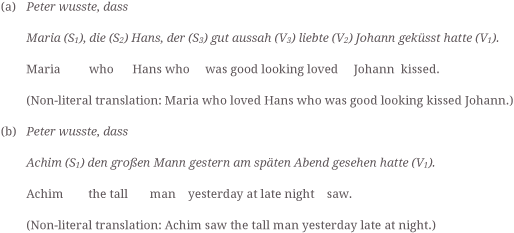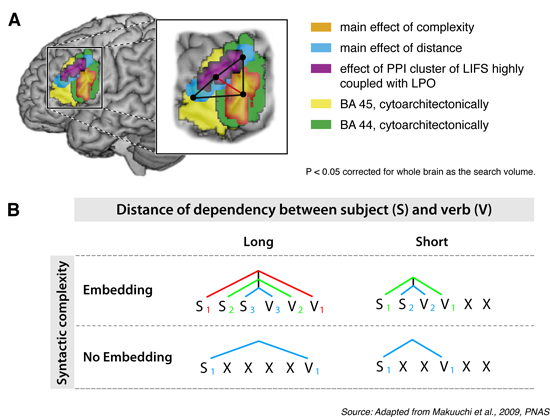Syntactic complexity and working memory
In the literature it is still hotly debated whether the role of Broca’s area in processing syntactically complex sentences is that of a syntactic parser or that of a working memory component. Previous work indicates that Broca’s area is involved in working memory (WM) (Wager & Smith, 2003) and that the processing of syntactically complex sentences does require some WM capacity (Cooke et al., 2002; Gibson & Perlmutter, 1998; Just & Carpenter, 1992). Based on these observations it is discussed to what extend the verbal WM involved in language comprehension is specific for syntax or not (Caplan & Waters, 1999; Fedorenko, Gibson & Rohde, 2006; Lewis, Vasishth & Van Dyke, 2006; Santi & Grodzinsky, 2007; Waters & Caplan, 1992).
Recently, a study investigated the interplay between syntax and working memory by crossing these two factors in syntactically complex, center-embedded sentences (Makuuchi et al., 2009). The factor WM was operationalized as the distance between the subject noun-phrase and its related verb, whereas the factor syntax was operationalized as the number of hierarchical embeddings (see Fig. 8). By varying the factors WM and syntax systematically the study was able to neuroanatomically segregate WM and syntax. Example sentences for the long distance condition are (a) embedded structure and (b) non-embedded structure are taken from Makuuchi et al. (2009) and displayed as in Friederici (2011).

The two main effects were located in different, but adjacent brain regions. The main effect of WM (distance) was located in the inferior frontal sulcus and the main effect of syntax (number of embedding) was located in BA 44 (Makuuchi et al., 2009) (see Fig. 8). These two areas strongly interact during sentence comprehension as revealed by a functional connectivity analysis.
In sum, these data suggest a neural separation of syntax and working memory in the inferior frontal cortex (IFC).

Figure 8: Syntactic complexity and working memory in the IFC
A: The factors syntactic complexity (hierarchy) and working memory (distance) in sentence processing are segregable with complexity being located in BA 44, i.e. left pars opercularis and working memory in the left inferior frontal sulcus. A functional connectivity analysis (PPI) revealed that during sentence processing these two brain regions closely interact with each other (indicated by red line). The cytoarchitectonically based parcellation of BA 45 and BA 44 is color coded in yellow and green, respectively. B: Schema of sentences constructed in a 2x2 design with the factors syntactic complexity (hierarchy) and working memory (distance between subject-noun phrase and related verb). Figure legend is taken from Friederici, 2011 (Physiological Reviews, 91(4), 1357-1392).